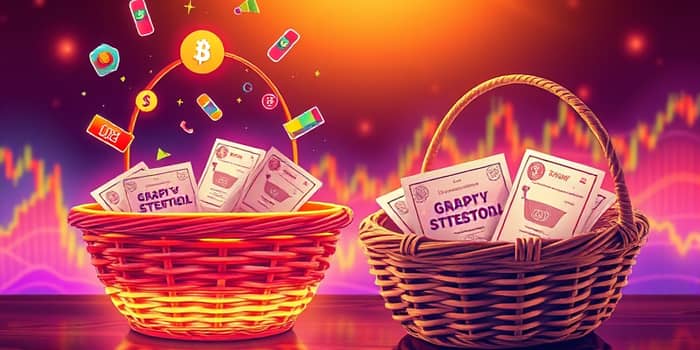Choosing the right investment vehicle can feel like navigating a maze of jargon and complex strategies. Yet, understanding the core attributes of ETFs and mutual funds unlocks the power to align your portfolio with your dreams. Whether you seek active management or prefer a passive, low-cost approach, this guide provides the insights you need.
By unraveling their mechanics, costs, tax implications, and strategic potential, you’ll gain the clarity to make empowered decisions and take confident steps toward your financial future.
Understanding the Basics of ETFs and Mutual Funds
Exchange Traded Funds (ETFs) and mutual funds both pool investors’ money to purchase diversified portfolios of stocks, bonds, or other securities. The main appeal lies in diversified exposure to multiple asset classes without the need to buy each security individually.
However, beneath this shared facade lie critical differences in how they trade, how they’re managed, and how investors interact with them. Grasping these distinctions will help you match each structure to your needs.
Trading Mechanics: Flexibility vs. Routine
One of the most immediate contrasts is how each fund trades:
- ETFs trade throughout the day like individual stocks, offering real-time pricing and instant execution.
- Mutual funds transact only once daily, after the market closes, at their calculated Net Asset Value (NAV).
This difference can be a game-changer for investors who value intraday trading flexibility and swift portfolio adjustments, or for those who prefer the simplicity of routine, end-of-day transactions.
Comparing Costs, Fees, and Management Styles
Costs and fees often dictate long-term returns. ETFs generally boast lower expense ratios, owing to streamlined operations and predominantly passive management styles that track market indices.
Mutual funds, especially actively managed ones, may carry higher fees and sometimes load charges. In return, they offer the opportunity for potential for outperformance with active management, as fund managers seek to beat benchmarks through research and security selection.
Consider these fee dynamics carefully: small percentage differences compound over decades, significantly affecting your final portfolio value.
Tax Efficiency and Minimum Investment Requirements
ETFs utilize an in-kind creation and redemption process that can minimize capital gains distributions, making them highly tax-efficient for buy-and-hold investors. Mutual funds may distribute realized gains to all investors whenever the manager buys or sells holdings, potentially creating tax liabilities.
Minimum investments also diverge. You can purchase as little as one share of most ETFs, while mutual funds often require initial investments ranging from several hundred to several thousand dollars.
Investment Suitability: Who Should Consider Which?
Your personal goals and style determine the best fit. ETFs may suit:
- Investors seeking low operating expense ratios and streamlined diversification.
- Active traders who value intraday trading and strategic timing.
- Buy-and-hold investors focused on tax-efficient wealth accumulation.
Mutual funds might appeal to:
- Those chasing outperformance through professional management.
- Investors committed to automatic, fixed-dollar monthly contributions.
- Participants in markets where active insight can add value.
Detailed Comparison Table
Below is a side-by-side view of the key characteristics to guide your evaluation:
Combining ETFs and Mutual Funds for a Balanced Portfolio
Rather than choosing one over the other, savvy investors often blend both:
Core holdings may consist of broad-market ETFs that deliver steady, low-cost index performance. Around this foundation, actively managed mutual funds can be added to pursue alpha in niche sectors or inefficient markets.
This hybrid approach harnesses the strengths of each vehicle: the cost-effectiveness and tax benefits of ETFs, alongside the potential for targeted outperformance through mutual funds.
Leading Providers and Recent Developments
Vanguard, Fidelity, and BlackRock dominate the ETF and mutual fund landscapes by offering robust platforms, research tools, and a wide array of low-cost products. Vanguard’s flagship ETF expense ratios are 82% lower than industry averages, empowering investors to keep more of their returns.
In 2024, the SEC’s approval of spot Bitcoin ETFs marked a landmark expansion of the ETF universe, signaling a future where digital assets join traditional stocks and bonds within these versatile vehicles.
Making the Final Call: Your Personalized Decision Framework
To determine which option aligns best with your objectives, consider these factors:
- Your investment goals and time horizon
- Risk tolerance and market volatility comfort
- Desire for active management versus passive tracking
- Tax considerations and account types
- Preferred trading frequency and automation needs
By mapping each criterion to the features outlined above, you can construct a portfolio that mirrors your vision—balancing cost, convenience, and the pursuit of growth.
Ultimately, there is no one-size-fits-all answer. Whether you harness the dynamic agility of ETFs, the strategic insight of mutual funds, or a blend of both, informed choices today pave the path to your financial tomorrow.
References
- https://www.schwab.com/etfs/mutual-funds-vs-etfs
- https://www.usbank.com/investing/financial-perspectives/investing-insights/etfs-vs-mutual-fund.html
- https://investor.vanguard.com/investor-resources-education/etfs/etf-vs-mutual-fund
- https://www.blackrock.com/americas-offshore/en/education/etf/comparing-etfs-and-mutual-funds
- https://www.investopedia.com/articles/exchangetradedfunds/08/etf-mutual-fund-difference.asp
- https://www.investopedia.com/articles/investing/110314/key-differences-between-etfs-and-mutual-funds.asp
- https://www.investopedia.com/articles/investing/021916/etfs-vs-mutual-funds-which-better-young-investors.asp
- https://us.etrade.com/knowledge/library/etfs/etfs-vs-mutual-funds










